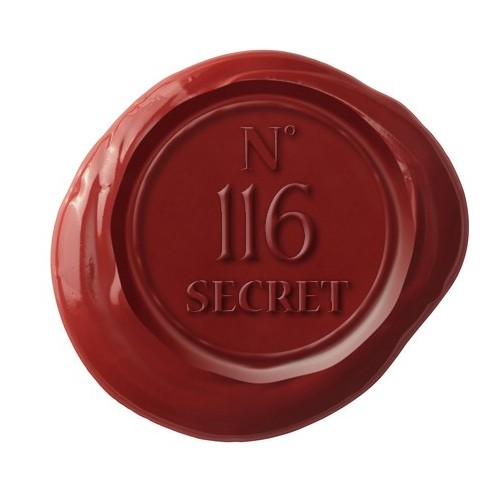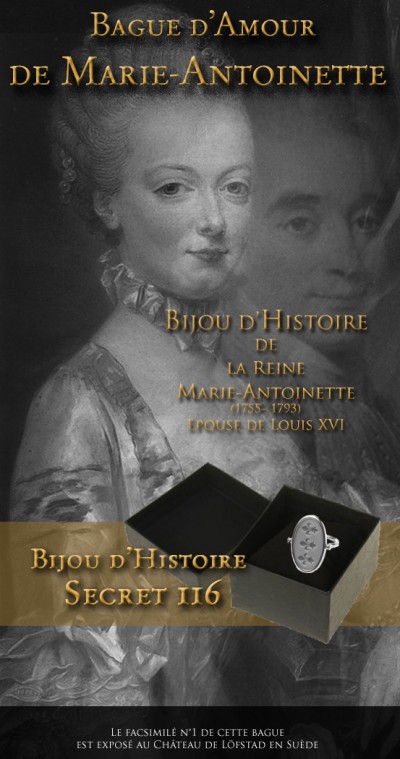
N° 116
Marie-Antoinette's talisman ring
1791 marks the beginning of the tragic end of Marie-Antoinette and King Louis XVI.
After having attempted to escape East in secret to join Bouille’s royalist army at Metz, whose goal was to firmly restore them to the throne, the royal family - who had left the Tuileries palace on the night of 20th June 1791 - was arrested at Varennes on the 21st...
1791 marks the beginning of the tragic end of Marie-Antoinette and King Louis XVI.
After having attempted to escape East in secret to join Bouille’s royalist army at Metz, whose goal was to firmly restore them to the throne, the royal family - who had left the Tuileries palace on the night of 20th June 1791 - was arrested at Varennes on the 21st. Louis XVI was instantly stripped of his titles and the royal family, who were labelled traitors to the nation, were returned to Paris and placed under high surveillance at the Tuileries.
Confined to her residence and kept under strict surveillance, Queen Marie-Antoinette maintained a coded correspondence with several of her devotees. Indeed, while several aristocrats, such as the Comte d’Artois (brother of Louis XVI and the future Charles X), had opted for exile the day after 14th July 1789, some of them had remained loyal to their monarch and had risked their lives to do whatever necessary to save them.
Among these was the Hungarian Count Valentin Esterhazy, a particular favourite of the Queen. This ‘compatriot’, whom the Queen thus named because he was a subject of the Habsburg empire, served at once as an officer with foreign powers, but also (and most importantly) as an intermediary with the Swedish Count Axel de Fersen, organizer of the failed escape but also (as we now know for sure) the Queen’s lover.
On the 5th September 1791, Marie-Antoinette, trapped in the Tuileries, wrote an enigmatic letter to Esterhazy.
Marie-Antoinette's Love ring
This is what the letter says:
‘I am happy to have found an opportunity to send you a small ring which will surely be to your liking. It has been sold here prodigiously for the last three days, and the greatest pain has been had in procuring it. The ring wrapped in paper is for Him. Have Him wear it: it is exactly his size. I wore it for two days before wrapping it. Let Him know that it is from me. I do not know where he is. It is a terrible torment to be ignorant of the whereabouts of those we love.’
This letter followed a letter that had already been written to Esterhazy on the 11th August 1791: ‘If you write to Him, tell Him that neither land nor sea can separate two hearts: every day I become more certain of this fact.’
To whom does this mysterious ‘Him’, complete with capital H, refer? Evidently, Axel de Fersen, her lover. Long suspected but never formally established, this affair has recently been clearly proven thanks to the results of recent studies conducted on Marie-Antoinette’s coded letters. Letters which were not only coded, but also censored some time in the nineteenth century, probably by Fersen himself, his descendants or the custodians of his letters. A dip into Esterhazy’s correspondence gives significant insights into the meaning of this unique letter from 5 September 1791. Several weeks after the Queen wrote the letter, on the 21st October 1791, the Hungarian Count wrote to his wife from Saint-Petersburg, employing the same coded names as Marie-Antoinette to refer to the protagonists:
‘I received a letter from Avillart that Bercheny gave to Coblence, and which he gave to the emissary with a small gold ring that bore the engraving: Domine salvum fac regem et reginam; you might have seen it? He has written to me that it is in the letter which has been sent you, and has indicated to me the way to get my letters to him. [...] He has also sent me a ring for the darling. But I do not know where to get it. His letter is touching; it recommends that I do not believe in calumny and that I should never doubt the nobility of his way of thinking, nor his courage.’
“Avillart” referred to Marie-Antoinette and the ‘darling’ referred to Fersen. The fact has thus been established: Marie-Antoinette did indeed send two rings to Count Esterhazy, one of which was intended for the man whose absence caused her so much suffering. Contrary to appearances, there was nothing extraordinary about her sending a ring to one of her devotees. Indeed, many Royalists rushed to the Tuileries palace to obtain a keepsake from the Queen. As memoirs from that time testify, Marie-Antoinette thus gave rings with symbolic royalist inscriptions such as Domine salvum fac regem et reginam… (Lord, save the King and Queen), a verse from a Biblical psalm put into a motet to be sung during Mass in the Ancien Regime. This verse was sung since Louis XIII’s reign in the royal chapel and these words can still be seen in the inscription on the chapel ceiling, above the organ, in the Chateau of Versailles.
On the other hand, what most merits our attention in the hindsight afforded to us by History, is that in spite of the danger, and beyond all the precautions taken and the coding of the content, Marie-Antoinette revealed two secrets in her letter. First, the addressee was so dear to her heart that she wore the ring for two days before wrapping it. Second, she knew the precise size of his fingers. Consequently, the recipient of the ring, a man in this case (‘HIM’), had already been sufficiently intimate with the Queen, flouting all conventions and customs, to have most likely already made her wear one of his rings, or to have worn one of the rings belonging to the Queen.
What rings are these? In 1905, when Esterhazy’s Memoirs were published, the editor Ernest Daudet mentioned one ring which remained in the possession of Paul Bezeredj, great-grandson of Count Esterhazy. According to the annotator, it was ‘entirely in gold, dual-sided. On one side, three fleurs de lys are engraved; on the other, the inscription: ‘It is a coward who abandons them.’’
The slogan ‘It is a coward who abandons them’ was widespread in 1791 among the Royalists, who used it as a kind of rallying cry, in the form of a warning. According to his obituary in 1852, the Marquis de Villeneuve-Arifat mentioned in his recollections to his family that during their final meeting at the Tuileries, the Queen had offered him a ‘talismanic ring’ with this very inscription.
Lost in the labyrithns of History
It is impossible to know with the information at our disposal whether or not the ring intended for Axel de Fersen ever reached him, or if the ring offered to Esterhazy actually contains the two slogans together on one and the same ring: one (Domine salvum fac regem et reginam), mentioned in Esterhazy’s correspondence, which might have been engraved on the inside of the ring, and the other (as the ring passed down to Paul Bezeredj would seem to confirm), ‘It is a coward who abandons them’, engraved on the outside. That is the line we have taken, Count Esterhazy having possibly refused to mention the second slogan, judging it too royalist and compromising because it was well-known and suggestive. Verification, however, remains impossible; the ‘Esterhazy ring’ disappeared from circulation and only a photograph of it remains…
It little matters. With this ring, History has retained a magnificent talisman of love that a Queen on the edge of the abyss, aware of her tragic and inescapable destiny and tortured by the absence of the man she yearned for so secretly, had wanted to nourish with all her heart and soul for two days before releasing it, as one flings a bottle into the sea. An ‘I love you’ declared for eternity...
Produits associés au Secret "secret d'Histoire 116: La bague talisman de Marie-Antoinette "
-
Marie-Antoinette's Love Ring to Axel de Fersen Marie-Antoinette's Love Ring to Axel de Fersen
Paris, Les Tuileries, 5 Septembre 1791 Reconstitution Historique Marie-Antoinette et Axel de Fersen se rencontrent lors d'un bal masqué le 30 janvier 1774. Instant magique où, sous les déguisements, naît une histoire d’amour. En 1791, emprisonnée, la reine envoie à son amant une bague d’amour... Bague en or avec chaton pivotant en cornaline Paris, Les Tuileries, 5 Septembre 1791 Reconstitution Historique Marie-Antoinette et Axel de Fersen se...
Not available
Chercher par thème
-
HUNT FOR Replicas and Objects of History
-
The "Historical Figures" Collection
-
Objects of History of Great Writers
- Objects and Products of History of Honoré de BALZAC
- Objects of History of MARCEL PROUST
- Objects and Products of History of ALEXANDRE DUMAS PÈRE
- Objects and Products of History of ARTHUR RIMBAUD
- Objects and Products of History of VICTOR HUGO
- Objects and Products of History of GUY DE MAUPASSANT
- Objects and Products of History of OSCAR WILDE
- Objects and Products of History of CHARLES BAUDELAIRE
- Objects and Products of History of JULES VERNE
- Objects and Products of History of GUSTAVE FLAUBERT
- Objets et Produits d'Histoire de JEAN COCTEAU
- Objets et Produits d'Histoire de CHAROTTE BRONTE
- Objets et Produits d'Histoire de LEWIS CAROLL
- Objects and Products of History of MOLIERE
-
Objects of History of Great Painters
- Objects and Products of History of ELISABETH VIGÉE LEBRUN
- Objects and Products of History of FRANÇOIS GÉRARD
- Objects and Products of History of CLAUDE MONET
- Objects and Products of History of HECTOR VIGER
- Objects and Products of History of MARTIN VAN MEYTENS
- Objects and Products of History of FRANZ XAVIER WINTERHALTER
- Objects and Products of History of VINCENT VAN GOGH
- Objects of History of Princes, Kings & Emperors
-
Objects of History of Princesses, Queens & Empresses
- Objects and Products of History of MARIE-ANTOINETTE
- Objects and Products of History of JOSÉPHINE DE BEAUHARNAIS
- Objects and Products of History of EMPRESS EUGÉNIE
- Objects and Products of History of ELISE DE BEAUHARNAIS
- Objects and Products of History of LAETITIA BONAPARTE
- Objects and Products of History of HORTENSE DE BEAUHARNAIS
- Objects and Products of History of PAULINE BONAPARTE
- Objects and Products of History of the COUNTESS OF PRESLE
- Objects and Products of History of Marquise of CAUMONT
- Objects and Products of History of Madame Elisabeth
- Objects and Products of History of ELEONORE VERGEOT
- Objects of History of Great Photographers
- Objects of History of Great Perfumers
- Objects of History of Immortal Artists
- Objects of History of Great Gastronomes
- Objects of History of Great Scientists
- Objects of History of Great Gardeners
-
Objects of History of Great Writers
- The "Arts and Crafts of History" Collection
- The "Famous Houses and Historical Shops" Collection
- The "Ancient and Always Existing Brands" Collection
-
The "Historical Figures" Collection
-
HUNT AFTER Hidden Secrets of History
-
Secrets of GREAT WRITERS
- Secrets of Honoré de Balzac
- Secrets of Marcel Proust
- Secrets of Alexandre Dumas Père
- Secrets of Arthur Rimbaud
- Secrets of Vicotr Hugo
- Secrets of Guy de Maupassant
- Secrets of Oscar Wilde
- Secrets of Charles Baudelaire
- Secrets of Jules Vernes
- Secrets of Jean Cocteau
- Secrets of Gustave Flaubert
- Secrets of Lewis Caroll
- Secrets of Charlotte Brontë
- Secrets of Molière
- Secrets of GREAT PAINTERS
- Secrets of PRINCES, KINGS & EMPERORS
-
Secrets of PRINCESSES, QUEENS & EMPRESSES
- Secrets of Marie-Antoinette
- Secrets of Joséphine de Beauharnais
- Secrets of Empress Eugénie
- Secrets of Elise de Beauharnais
- Secrets of Laetitia Bonaparte
- Secrets of Hortense de Beauharnais
- Secrets of Pauline Bonaparte
- Secrets of Eléonore de Vergeot
- Secrets of the Countess of Presle
- Secrets of Madame Elisabeth
- Secrets of the Marquise de Caumont
- Secrets of GREAT PHOTOGRAPHERS
- Secrets of GREAT PERFUMERS
- Secrets of IMMORTAL ARTISTS
- Secrets of GREAT GASTRONOMES
- Secrets of GREAT SCIENTISTS
- Secrets of Great Gardeners
-
Secrets of GREAT WRITERS
- HUNT AROUND Hidden and Famous Places of History
Wishlist
Top sellers
-

Jardin le Nôtre - Eau de Parfum
Reinterpreted Perfume Of History In order to celebrate the fourth...
10,00€ -

Bouquet du Trianon - Eau de Toilette
Reinterpreted Perfume Of History Versailles, 15th of August 1774 Art...
59,00€ -

Orangerie du Roy - Eau de Toilette
reinterpreted Perfumes of History Versailles, September 1rst 1689...
59,00€ -

Rose de France - Perfumed Soap
reinterpreted Scents of History Rose de France plunges us into the...
6,50€




